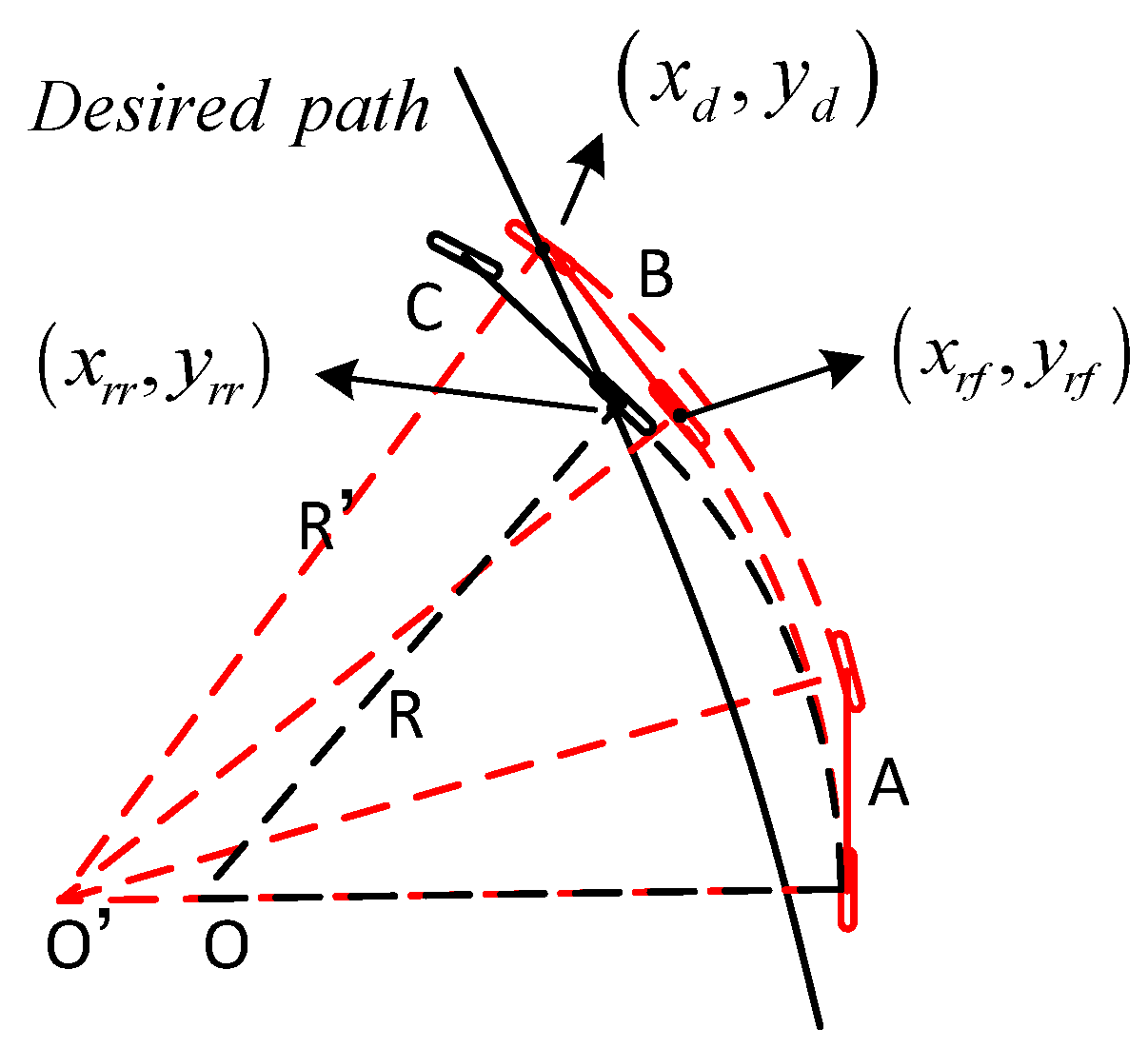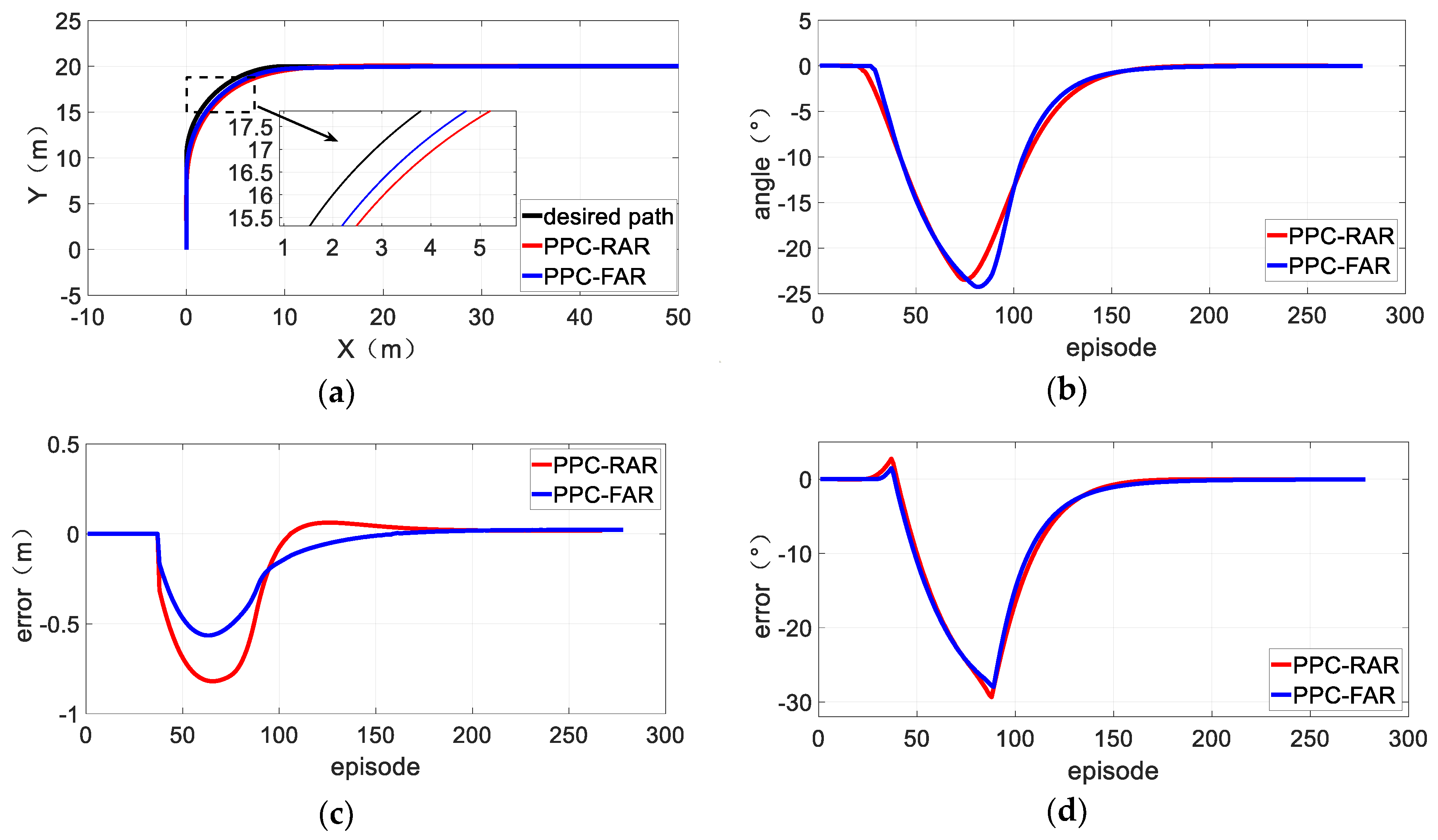Driverless Bus Path Tracking Based on Fuzzy Pure Pursuit Control with a Front Axle Reference
Abstract
:Featured Application
Abstract
1. Introduction
- (1)
- For lateral control, a FPPC-FAR path-tracking controller is proposed. Firstly, Pure Pursuit Control Based on a Front Axle Reference (PPC-FAR) path-tracking controller is adopted. It moves the reference point of Pure Pursuit to the front axle to relieve the ignorance’s influence on lateral control. A coefficient is also added to merge the difference between the proposed model and the real bus. Secondly, the look-ahead distance and coefficient are provided by a fuzzy logic interface machine, which improves the accuracy and robustness of the path-tracking controller.
- (2)
- For longitudinal control, a feedback-feedforward control algorithm is constructed. In feedback control, a proportional-integral (PI) controller is utilized to track the desired velocity. To avoid the jump of desired velocity, the Tracking Differentiator (TD) is introduced to calculate the transient profile of the desired velocity [26]. In feedforward control, the component of gravitational acceleration is applied as the compensation to deceleration. Furthermore, the compensation of the desired velocity is also calculated according to the road slope, which relieves the effect of the road slope.
2. Controller Design
2.1. The Model of the Driverless Bus
2.2. Lateral Control
2.2.1. Pure Pursuit Controller with a Rear Axle Reference
2.2.2. Pure Pursuit Controller with a Front Axle Reference
2.2.3. Fuzzy Pure Pursuit with Front Axle Reference
- (1)
- When is small and is large, in order to achieve a trade-off between accuracy and stability of PPC-FAR, and should be large.
- (2)
- When is large and is small, in order to guarantee the tracking accuracy and merge the gap between real bus and kinematic model, and should be small.
2.3. Longitudinal Control
3. Simulations
3.1. Simulation of Lateral Control
3.1.1. Stability Analysis
3.1.2. Adaptability Analysis
3.2. Simulation of Longitudinal Control
4. Real Bus Experiments
5. Conclusions
Author Contributions
Funding
Conflicts of Interest
References
- Hugo Neves de Melo, H.N.; Trovão, J.P.F.; Pereirinha, P.G.; Jorge, H.M.; Antunes, C.H. A Controllable Bidirectional Battery Charger for Electric Vehicles with Vehicle-to-Grid Capability. IEEE Trans. Veh. Technol. 2018, 67, 114–123. [Google Scholar] [CrossRef]
- Ji, J.; Khajepour, A.; Melek, W.W.; Huang, Y. Path Planning and Tracking for Vehicle Collision Avoidance Based on Model Predictive Control With Multiconstraints. IEEE Trans. Veh. Technol. 2017, 66, 952–964. [Google Scholar] [CrossRef]
- Bai, G.; Liu, L.; Meng, Y.; Luo, W.; Gu, Q.; Ma, B. Path Tracking of Mining Vehicles Based on Nonlinear Model Predictive Control. Appl. Sci. 2019, 9, 1372. [Google Scholar] [CrossRef] [Green Version]
- Taghavifar, H. Neural Network Autoregressive With Exogenous Input Assisted Multi-Constraint Nonlinear Predictive Control of Autonomous Vehicles. IEEE Trans. Veh. Technol. 2019, 68, 6293–6304. [Google Scholar] [CrossRef]
- Guo, H.; Liu, J.; Cao, D.; Chen, H.; Yu, R.; Lv, C. Dual-envelop-oriented moving horizon path tracking control for fully automated vehicles. Mechatronics 2018, 50, 422–433. [Google Scholar] [CrossRef] [Green Version]
- Zhang, C.; Hu, J.; Qiu, J.; Yang, W.; Sun, H.; Chen, Q. A Novel Fuzzy Observer-Based Steering Control Approach for Path Tracking in Autonomous Vehicles. IEEE Trans. Fuzzy Syst. 2019, 27, 278–290. [Google Scholar] [CrossRef]
- De Jesús Rubio, J. Robust feedback linearization for nonlinear processes control. ISA Trans. 2018, 74, 155–164. [Google Scholar] [CrossRef]
- Rubio, J.D.J.; Ochoa, G.; Mujica-Vargas, D.; Garcia, E.; Balcazar, R.; Elias, I.; Cruz, D.R.; Juarez, C.F.; Aguilar, A.; Novoa, J.F. Structure Regulator for the Perturbations Attenuation in a Quadrotor. IEEE Access 2019, 7, 138244–138252. [Google Scholar] [CrossRef]
- Tumari, M.Z.M.; Abidin, A.F.Z.; Hussin, M.S.F.; Kadir, A.M.A.; Aras, M.S.M.; Ahmad, M.A. PSO Fine-Tuned Model-Free PID Controller with Derivative Filter for Depth Control of Hovering Autonomous Underwater Vehicle. Methods Mol. Biol. 2019, 3–13. [Google Scholar] [CrossRef]
- Soliman, M.A.; Azar, A.T.; Saleh, M.A.; Ammar, H.H. Path Planning Control for 3-Omni Fighting Robot Using PID and Fuzzy Logic Controller. Int. Conf. Adv. Mach. Learn. Technol. Appl. 2019, 921, 442–452. [Google Scholar]
- Yin, J.; Zhu, D.; Liao, J.; Zhu, G.; Wang, Y.; Zhang, S. Automatic Steering Control Algorithm Based on Compound Fuzzy PID for Rice Transplanter. Appl. Sci. 2019, 9, 2666. [Google Scholar] [CrossRef] [Green Version]
- Kumar, J.; Kumar, V.; Rana, K. Design of robust fractional order fuzzy sliding mode PID controller for two-link robotic manipulator system. J. Intell. Fuzzy Syst. 2018, 35, 1–15. [Google Scholar] [CrossRef]
- De Jesús Rubio, J. Hybrid controller with observer for the estimation and rejection of disturbances. ISA Trans. 2016, 65, 445–455. [Google Scholar] [CrossRef] [PubMed]
- Jia, L.; Wang, Y.; Zhang, C.; Zhao, K.-H.; Liu, L.; Nguyễn, X. A Robust Adaptive Trajectory Tracking Algorithm Using SMC and Machine Learning for FFSGRs with Actuator Dead Zones. Appl. Sci. 2019, 9, 3837. [Google Scholar] [CrossRef] [Green Version]
- Yu, L.; Kong, D.; Shao, X.; Yan, X. A Path Planning and Navigation Control System Design for Driverless Electric Bus. IEEE Access 2018, 6, 53960–53975. [Google Scholar] [CrossRef]
- Gonzalez, D.; Perez, J.; Milanes, V.; Nashashibi, F. A Review of Motion Planning Techniques for Automated Vehicles. IEEE Trans. Intell. Transp. Syst. 2016, 17, 1135–1145. [Google Scholar] [CrossRef]
- Wu, T. Path tracking control for a robot-trailer system with parameter tuning using particle swarm optimization. In Proceedings of the 2018 IEEE International Conference on Mechatronics and Automation, Changchun, China, 5–8 August 2018. [Google Scholar]
- Zhang, B.; Zong, C.; Chen, G.; Zhang, B. Electrical Vehicle Path Tracking Based Model Predictive Control With a Laguerre Function and Exponential Weight. IEEE Access 2019, 7, 17082–17097. [Google Scholar] [CrossRef]
- Thrun, S.; Montemerlo, M.; Dahlkamp, H.; Stavens, D.; Aron, A.; Diebel, J.; Fong, P.; Gale, J.; Halpenny, M.; Hoffmann, G.M. Stanley: The Robot That Won the DARPA Grand Challenge. J. Field Robot. 2006, 23, 661–692. [Google Scholar] [CrossRef]
- Cui, Q.; Ding, R.; Zhou, B.; Wu, X. Path-tracking of an autonomous vehicle via model predictive control and nonlinear filtering. Proc. Inst. Mech. Eng. Part D J. Automob. Eng. 2017. [Google Scholar] [CrossRef]
- Yao, Q.; Tian, Y. A Model Predictive Controller with Longitudinal Speed Compensation for Autonomous Vehicle Path Tracking. Appl. Sci. 2019, 9, 4739. [Google Scholar] [CrossRef] [Green Version]
- Challa, V.; Ratnoo, A. Virtual Target based Obstacle Avoiding Guidance. IFAC Pap. 2018, 51, 214–218. [Google Scholar] [CrossRef]
- Qiu, W.; Qu, T.; Yu, S.; Guo, H.; Hong, C. Autonomous vehicle longitudinal following control based on model predictive control. In Proceedings of the 2015 34th Control Conference, Hangzhou, China, 28–30 July 2015. [Google Scholar]
- Kim, W.; Chang, M.K.; Son, Y.S.; Lee, S.H.; Chung, C.C. Vehicle Path Prediction Using Yaw Acceleration for Adaptive Cruise Control. IEEE Trans. Intell. Transp. Syst. 2018, 19, 3818–3829. [Google Scholar] [CrossRef]
- Yao, B.; Yang, J.; Zhang, Q.; Guo, Z.; Hu, R. Research and comparison of automatic control algorithm for unmanned ship. In Proceedings of the 2018 3rd International Conference on Control and Robotics Engineering (ICCRE), Nagoya, Japan, 20–23 April 2018; pp. 85–89. [Google Scholar] [CrossRef]
- Li, H.; He, B.; Yin, Q.; Mu, X.; Zhang, J.; Wan, J.; Wang, D.; Shen, Y. Fuzzy Optimized MFAC Based on ADRC in AUV Heading Control. Electronics 2019, 8, 608. [Google Scholar] [CrossRef] [Green Version]
- Zhang, H.; Xie, Y.; Xiao, G.; Zhai, C.; Long, Z. A Simple Discrete-Time Tracking Differentiator and Its Application to Speed and Position Detection System for a Maglev Train. IEEE Trans. Control Syst. Technol. 2019, 27, 1728–1734. [Google Scholar] [CrossRef]
- Zhang, H.; Xie, Y.; Xiao, G.; Zhai, C. Closed-form solution of discrete-time optimal control and its convergence. IET Control Theory Appl. 2018, 12, 413–418. [Google Scholar] [CrossRef]























| Symbol | Quantity | Value | Symbol | Quantity | Value |
|---|---|---|---|---|---|
| mcg | Bus total mass | 17,800 (kg) | a | Distance from center of mass to front axle | 2.795 (m) |
| l | Length | 11,950 (mm) | b | Distance from center of mass to rear axle | 3.105 (m) |
| w | Width | 2540 (mm) | Iz | Inertia | 20,000 (kg m2) |
| h | Height | 3350 (mm) | Cf | Front wheel cornering stiffness coefficient | 6500 (N/rad) |
| d | Wheelbase | 5.9 (m) | Cr | Rear wheel cornering stiffness coefficient | 5200 (N/rad) |
| s | NB | NM | NS | ZO | PS | PM | PB | ||
|---|---|---|---|---|---|---|---|---|---|
| ld | |||||||||
| v | |||||||||
| NB | NB | NB | NM | NS | ZO | PS | PS | ||
| NM | NB | NM | NS | ZO | ZO | PS | PS | ||
| NS | NM | NS | ZO | ZO | PS | PS | PM | ||
| ZO | NM | NS | NS | ZO | PS | PM | PM | ||
| PS | NS | NS | ZO | ZO | PS | PM | PM | ||
| PM | NS | ZO | ZO | PS | PM | PM | PB | ||
| PB | ZO | PS | PS | PS | PM | PB | PB | ||
| s | NB | NM | NS | ZO | PS | PM | PB | ||
|---|---|---|---|---|---|---|---|---|---|
| k | |||||||||
| v | |||||||||
| NB | PB | PB | PB | PS | ZO | NS | NB | ||
| NM | PB | PB | PB | PS | ZO | NS | NB | ||
| NS | PB | PB | PB | PS | ZO | NS | NB | ||
| ZO | PB | PB | PM | ZO | NS | NM | NB | ||
| PS | PB | PB | PM | ZO | NM | NB | NB | ||
| PM | PB | PB | PM | NS | NM | NB | NB | ||
| PB | PB | PB | PM | NS | NM | NB | NB | ||
| Algorithm | v (km/h) | ld (m) | Lateral Error | Final State | Algorithm | v (km/h) | ld (m) | Lateral Error | Final State |
|---|---|---|---|---|---|---|---|---|---|
| PPC-RAR | 10 | 15 | 0.02 | oscillate | PPC-FAR | 10 | 10 | 0 | stable |
| 20 | 0.03 | oscillate | |||||||
| 30 | 15 | 0.05 | oscillate | 30 | 15 | 0.01 | stable | ||
| 20 | 0.05 | oscillate | 20 | 0.01 | stable | ||||
| 60 | 20 | 0.06 | oscillate | 25 | 25 | 0.04 | oscillate |
| Parameter | Feedback Control | Feedforward Control | |||
|---|---|---|---|---|---|
| value | 4 | 0.01 | 0.19 | 0.001 | 0.01 |
| Parameters | Feedback Control | Feedforward Control | |||
|---|---|---|---|---|---|
| value | 4 | 0.01 | 0.23 | 0.0015 | 0.05 |
© 2019 by the authors. Licensee MDPI, Basel, Switzerland. This article is an open access article distributed under the terms and conditions of the Creative Commons Attribution (CC BY) license (http://creativecommons.org/licenses/by/4.0/).
Share and Cite
Yu, L.; Yan, X.; Kuang, Z.; Chen, B.; Zhao, Y. Driverless Bus Path Tracking Based on Fuzzy Pure Pursuit Control with a Front Axle Reference. Appl. Sci. 2020, 10, 230. https://doi.org/10.3390/app10010230
Yu L, Yan X, Kuang Z, Chen B, Zhao Y. Driverless Bus Path Tracking Based on Fuzzy Pure Pursuit Control with a Front Axle Reference. Applied Sciences. 2020; 10(1):230. https://doi.org/10.3390/app10010230
Chicago/Turabian StyleYu, Lingli, Xiaoxin Yan, Zongxu Kuang, Baifan Chen, and Yuqian Zhao. 2020. "Driverless Bus Path Tracking Based on Fuzzy Pure Pursuit Control with a Front Axle Reference" Applied Sciences 10, no. 1: 230. https://doi.org/10.3390/app10010230
APA StyleYu, L., Yan, X., Kuang, Z., Chen, B., & Zhao, Y. (2020). Driverless Bus Path Tracking Based on Fuzzy Pure Pursuit Control with a Front Axle Reference. Applied Sciences, 10(1), 230. https://doi.org/10.3390/app10010230






